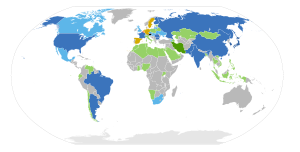- South African Nuclear Energy Corporation
-
The South African Nuclear Energy Corporation (NECSA) was established as a public company by the Republic of South Africa Nuclear Energy Act[1] in 1999 and is wholly owned by the State. The name is correctly indicated above, although the sequence of letters in the acronym may be taken as suggesting that the name should be the "Nuclear Energy Corporation of South Africa".[2]
NECSA replaced the country's Atomic Energy Corporation. Apart from several ancillary functions, the main functions of NECSA are to undertake and promote research and development in the field of nuclear energy and related technologies; to process and store nuclear material and other restricted material; and to co-ordinate with other organisations in matters falling within these spheres. Apart from its main operations at Pelindaba, NECSA also operates the Vaalputs radioactive waste-disposal facility. The Corporation also serves the State's other nuclear institutional obligations. The chief executive officer of NECSA is Dr Rob Adam (since 2006).
NECSA is organisationally divided into a commercial group, Pelindaba Technology (PT), which conducts business in a variety of products and markets and another group, Pelindaba Nuclear Institute (PNI), which is concerned with statutory functions, R&D, support and facility operations. Pelindaba Technology (PT) is a portfolio of businesses of which Nuclear Technology Products (NTP) is a division and serves the international markets for radiation-based technology and products. Also The Uranium Enrichment Corporation of South Africa, Ltd. (UCOR) which operated a facility at Valindaba (known as the 'Y'plant) to produce HEU.
NECSA employs some 1.400 people in diverse areas such as physics, engineering, chemistry and electronics. With changes in the country’s positioning on nuclear involvement and South Africa’s re-entry into world markets in 1990, a decision was taken to focus the organisation on commercially driven projects. Today, NECSA supplies a wide range of innovative hi-technology products and services to South African and foreign market sectors with the SAFARI-1 reactor as the cornerstone of the commercial isotope production programme. This research reactor at Pelindaba, SAFARI-1, is now the most commercialised nuclear reactor in the world with ISO 9000 accreditation and is earning South Africa millions of rands' worth of foreign revenue.
The 20 MW research reactor SAFARI-1 was initially used for high level nuclear physics research programmes and was commissioned in 1965. In the 1970s and 1980s the focus of activities at Pelindaba was on the exploitation of South Africa’s uranium resources through the successful design, construction and commissioning of commercial uranium hexafluoride, uranium enrichment, and nuclear fuel assembly production facilities.
See also
- Helikon vortex separation process
- Nuclear fuel cycle
- Nuclear reprocessing
- South Africa and weapons of mass destruction
References
- ^ "Nuclear Energy Act, No. 46 of 1999". South African Government Information. http://www.info.gov.za/view/DownloadFileAction?id=70613. Retrieved 2010-10-07.
- ^ See the 'About us' page on NECSA's website. While the correct name is usually used on its website, there is one instance where the incorrect name, "Nuclear Energy Corporation of South Africa", is used on the site. Elsewhere on the web, NECSA's incorrect name is often used.
External links
- South African Nuclear Energy Corporation (NECSA) Web site
- Nuclear Liabilities Management, a division of NECSA tasked with Nuclear Waste management
- NTP Radioisotopes, a division of NECSA involved in the production and distribution of
South African nuclear sites Current nuclear reactors Potential future nuclear reactors Enrichment plants Waste disposal sites VaalputsOperators Eskom · South African Nuclear Energy Corporation (NECSA)Nuclear power by country GWe > 10 Canada · China · EU (France · Germany · United Kingdom) · Japan · Russia · South Korea · Ukraine · United States
GWe > 2 EU (Belgium · Czech Republic · Finland · Spain · Sweden) · India · Republic of China (Taiwan) · SwitzerlandGWe > 1 GWe < 1 Planned Phasing-out Opposed Categories:- Companies of South Africa
- Nuclear technology companies
- Nuclear technology in South Africa
- South African nuclear sites
Wikimedia Foundation. 2010.

